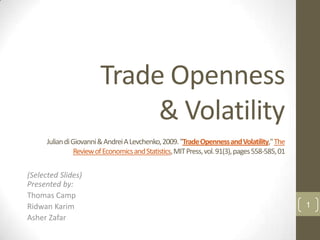
International Trade and Macroeconomic Volatility
- 1. Trade Openness & Volatility Julian di Giovanni & Andrei A Levchenko, 2009. "Trade Openness and Volatility,"The Review of Economics and Statistics, MIT Press, vol. 91(3), pages 558-585, 01 (Selected Slides) Presented by: Thomas Camp Ridwan Karim 1 Asher Zafar
- 2. Why do we care about volatility? • Standard deviation of GDP per capita a standard measure of macroeconomic volatility • Macroeconomic volatility has effects on welfare, inequality and poverty • Trade openness is one of the determinants of macroeconomic volatility • Correlation between trade openness and volatility is positive in the data 2
- 3. Trade openness and GDP growth volatility 3
- 4. How does trade effect volatility? • No consensus on the mechanisms through which trade openness affects volatility • Industry-level panel data set on production and trade employed in this paper for • 61 countries • 28 manufacturing sectors • Time period 1970-1999 4
- 5. Effects of trade on volatility 1. Sector-level volatility: • Trade openness is positively associated with changes in the volatility of individual sectors. 2. Comovement: • Trade openness is negatively associated with correlation between sectors within a countries economy, reducing volatility 3. Specialization: • Trade openness leads to greater specialization, and greater volatility. 5
- 6. Change in Aggregate Volatility 25th percentile 75th percentile of trade openness Sector-Level Volatility 13.5% 6.2% Comovement 17.3% 6 Specialization 10.2%
- 7. Country and time effects • Country-specific effects: Developing countries experience an increase in volatility five times higher than developed countries for the same increase in trade openness • Time varying effects: the impact of the same trade opening on aggregate volatility in the 1990s is double what it was in the 1970s. 7
- 8. Results • 8
- 9. Specialization and Trade Openness 9
- 10. Back to aggregate volatility… • 10
- 11. Partial effects of each channel on aggregate volatility • How do you expect these effects to vary for developing nations? Over time? • Sector Volatility Effect Aggregate Comovement Effect Volatility Specialization Effect 11
- 12. Estimating partial effects • Sector “Other sector” Comovement Specialization Volatility volatility 12
- 13. Change in aggregate volatility 25th 75th percentile of trade openness Sector Aggregate Comovement Specialization Volatility volatility • “Trade openness increased by about 30 percentage 13 points over the period, going from below 60% in the 1970s to almost 90% in the 1990s”
- 14. Volatility effects for varying country characteristics Sector Aggregate Comovement Specialization Volatility volatility • “The impact of the same trade opening is likely to be five times 14 higher in absolute terms for a typical developing country compared with a typical developed country”
- 15. Volatility effects by decade 1970s 1980s 1990s • Greater trade is amplifying the impact of these effects 15 on aggregate volatility over time
Editor's Notes
- -We already have h, ro, sigma, etc.-We need to estimate delta terms to compute magnitudes
- -We estimate these to plug into previous equation-The magnitude of sector volatility and specialization are higher for developing nations.-Less comovement (prob due to spec and trade) in developing nations. Sector specific shocks?-Other sector volatility closely mirrors aggregate volatility. Lower for developed nations
- -Change in absolute volatilityvs change in share of volatility-Change in openness developing nations has a 5x greater effect on volatility, and a greater share of volatility (due to increased specialization?)-Developing countries are considerably more volatile, somewhat less diversified, and have lower average comovement of sectors-Increasing share of volatility over time… trade is moving against the trend of less volatility
- Increase in sector volatility increases aggregate volatility 5x. Doubles comovement, 4x specialization, etc.Comovement lower for developing nations (more specialized)Specialization higher for developing nations